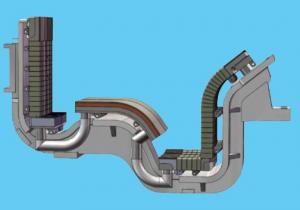SOLPS-ITER code used to design new EAST divertor
In order to enhance the power handling capability of the EAST tokamak's lower divertor, scientists put forward a new comprehensive solution called the "corner slot" divertor, which represents an upgrade in both shape and material on this medium-size tokamak that has been in operation in Hefei, China, since 2006.
The EAST team at the Institute of Plasma Physics, Chinese Academy of Sciences (ASIPP) has developed and installed a new lower divertor upgrade concept.
This is an actively-cooled tungsten divertor, inspired by the tungsten monoblock technology used to build the ITER divertor. Using the state-of-the-art edge plasma modelling tool SOLPS-ITER, distributed and maintained by the ITER Organization, the team discovered a new divertor operation regime with enhanced performance, relying on the "corner effect."
The corner effect can be achieved if the magnetic separatrix hits the divertor close to (within a centimetre or so) a sharp corner. It promotes plasma detachment, which protects the divertor target surface; such features are also included in the ITER divertor design.
Building an actively-cooled tungsten monoblock divertor with a sharp corner was not without its challenges, however, and a recently published article in Nuclear Fusion details the scientific basis and engineering solutions used for this new hardware.
See the Chinese Academy Of Sciences press release in English.


